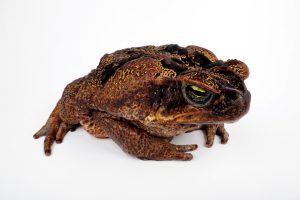South Florida’s lush landscape and subtropical climate make it a paradise for both humans and a diverse range of wildlife. However, in recent years, an invasive species has become a growing concern for the region, especially concerning our beloved pets. The invasi ve cane toad, also known as the Bufo toad, has established itself in South Florida and poses a significant hazard to pets.
ve cane toad, also known as the Bufo toad, has established itself in South Florida and poses a significant hazard to pets.
Cane Toads in South Florida
Cane toads are not native to the United States, but they were introduced in the 1930s in an attempt to control agricultural pests. Unfortunately, they have since spread across South Florida, making themselves at home in the warm and humid climate. These toads are known for their large size, warty skin, and distinctive triangle glands behind their eyes, which secrete a toxic substance when threatened.
Hazard to Pets
Cane toads have become a significant concern for pet owners in South Florida due to their toxicity. These toads secrete a potent venom that can be fatal to dogs and cats. When pets come into contact with cane toad venom, it can lead to severe health issues and, in some cases, even death.
The venom is most commonly ingested when pets play with or bite the toads. The symptoms of cane toad poisoning in pets can include:
- Excessive salivation
- Pawing at the mouth, shaking head side to side
- Vomiting
- Rapid or irregular heartbeats
- Seizures
- Loss of coordination
- Paralysis
- Coma
If you suspect your pet has come into contact with a cane toad, the first thing you want to do is rinse your pet’s mouth out with running water and wipe it with a wet towel then it is crucial to seek immediate veterinary attention. Time is of the essence, as the venom can quickly lead to severe consequences.
Precautions for Pet Owners

- Educate yourself and your family about the presence of cane toads in the area.
- Supervise your pets, especially during outdoor activities, to prevent them from coming into contact with cane toads.
- Teach your children and other family members not to handle these toads.
- Keep your yard and outdoor spaces free of standing water, which can attract cane toads.
Humanely removing cane toads is important, especially in regions where they have become invasive. Here are some steps you can take to remove cane toads humanely:
-
Identification: Before removing cane toads, ensure you can correctly identify them. Cane toads have large, warty skin and distinctive triangle glands behind their eyes. These glands secrete toxic substances when the toads are threatened.
-
Capture at night: Cane toads are most active at night. Use a flashlight to spot them. Approach slowly and carefully, as sudden movements may cause them to jump away.
-
Hand capture: If you’re comfortable doing so, you can use gloves to gently pick up the cane toad. Be sure to grasp it gently but securely to avoid harming the toad or exposing yourself to its toxins. Wear gloves to protect yourself from potential toxins.
-
Freeze humanely: Some organizations recommend a method known as humane euthanasia, which involves freezing the cane toad to minimize suffering. Place the toad in a sealed container, put it in the freezer, and leave it for several hours to ensure it is euthanized humanely.
-
Use traps: You can set up traps specifically designed for capturing cane toads. These traps are less stressful, safer for the toads, and available for purchase.
-
Do not use chemicals: Avoid using chemicals, pesticides, or toxins to eliminate cane toads, as these methods can harm other non-target species and may not be effective in the long term.
-
Prevent future infestations: After removing cane toads, take steps to prevent reinfestation. This may include securing your property, removing potential food sources, and ensuring that there are no breeding sites for the toads on your premises.
 Remember that it’s crucial to handle cane toads with care, both for your own safety and for the well-being of these invasive creatures. Whenever possible, seek assistance from local wildlife or environmental authorities, as they can provide expert guidance on humane removal methods and may offer resources to help manage the cane toad population in your area.
Remember that it’s crucial to handle cane toads with care, both for your own safety and for the well-being of these invasive creatures. Whenever possible, seek assistance from local wildlife or environmental authorities, as they can provide expert guidance on humane removal methods and may offer resources to help manage the cane toad population in your area.
Conclusion
Cane toads have become unwelcome in South Florida, posing a significant pet hazard. The venom of these invasive toads can have severe and potentially lethal effects on dogs and cats. As responsible pet owners, it is crucial to take precautions to protect our furry companions and be vigilant regarding the presence of cane toads in the area. Educating ourselves and taking proactive steps to keep our pets safe can reduce the risks posed by these toxic invaders. Find out more and see photos and videos here https://edis.ifas.ufl.edu/publication/UW432 and https://myfwc.com/wildlifehabitats/profiles/amphibians/cane-toad/.
 5
5
